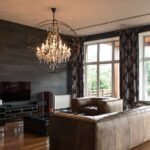
Your home should be more than just a place to crash at the end of the day. It’s where you rest, recharge, and spend time with the people who matter most. That’s why thoughtful design can have a surprising impact on your health and happiness.
Wellness-focused interior design isn’t just about adding plants or painting everything sage green. It’s about creating a space that supports how you feel – physically, mentally, and emotionally – every single day.
Design choices influence everything from your sleep quality to your stress levels. And the good news? You don’t need a full renovation to feel the difference.
Start in the Kitchen Where Wellness Begins
The kitchen isn’t just the heart of the home – it’s the command center for your health. If you’re prepping meals, trying to stay hydrated, or keeping up with vitamins and supplements, how this space is set up matters more than you think.
A simple but powerful change? Filtered water. Clean drinking water supports everything from digestion to skin health.
Installing a system like those from Woder is a low-effort way to level up your hydration game. Keeping a reusable bottle filled and visible on the counter is a small habit tweak that can make a big difference.
Other ideas: store fresh fruit in plain sight, keep clutter to a minimum, and use open shelving for easy access to your healthiest go-to ingredients. Consider adding a budget friendly slow juicer to your countertop setup. Being able to whip up fresh juice easily can be a game-changer for your morning routine. The easier it is to make a smart choice, the more likely you’ll do it.
Use Light to Support Your Energy and Mood
Lighting affects your mood, energy, and even how well you sleep. Exposure to natural light during the day helps regulate your circadian rhythm and boosts serotonin levels. A lack of it can lead to sluggishness and seasonal dips in motivation.
To get more daylight, swap heavy curtains for sheers or leave windows uncovered where privacy allows. Strategically placed mirrors can also help bounce sunlight around the room.
In darker spaces, especially in winter, use full-spectrum LED bulbs that simulate natural daylight. In the evening, switch to warm, ambient lighting – think table lamps and dimmable bulbs – to encourage your body to wind down.
Choose Materials That Support a Healthier Home
What your home is made of matters. Many mass-market materials – from flooring adhesives to synthetic fabrics – contain VOCs (volatile organic compounds), which can contribute to poor indoor air quality over time.
Look for low-VOC or VOC-free paints and sealants. Choose furniture made from solid wood rather than particleboard or MDF, which often contain formaldehyde. Use rugs made from natural fibers like jute, cotton, or wool instead of synthetics.
These choices aren’t just better for your lungs – they also tend to be more durable and visually appealing.
Add Texture and Nature to Calm the Senses
Wellness isn’t just about avoiding toxins or improving function. It’s also about how a space makes you feel. Nature-inspired design – often called biophilic design – has been shown to reduce stress and increase a sense of well-being.
You can introduce this feeling through texture and natural materials. Think wooden accents, soft linen throws, woven baskets, leafy plants, stone surfaces, and wool rugs. These elements help bring balance to modern interiors, which can sometimes feel too smooth and sterile.
Try to create contrast – mix soft with structured, rough with smooth – to make a room feel layered and inviting.
Pay Attention to the Spaces You Overlook
It’s easy to focus on the rooms guests see – the living room, the dining area – but your private spaces have just as much (if not more) influence on your daily wellness.

In the bathroom, opt for softer lighting and add small touches like a eucalyptus bundle in the shower or a bamboo bath mat.
Let Your Home Support Who You Want to Be
You don’t need a perfect home. You need one that works for you. The goal of wellness design isn’t a magazine-worthy aesthetic – it’s to create an environment that makes your everyday life smoother, calmer, and more intentional.
Start small. Change a lightbulb. Clear a surface. Swap one synthetic fabric for something natural. Add one houseplant. These simple actions build momentum.
As your habits grow, your space can grow with you – becoming a quiet partner in helping you feel your best.







